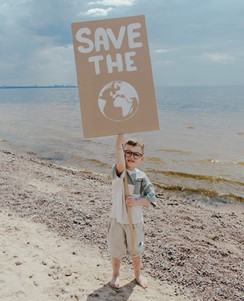Reuse Wear, Care and Repair

Caring for your clothes can make a big difference to the environment
Every year an estimated 336,000 tonnes of used clothing gets thrown away in the UK, ending up in landfill or going to energy from waste. Currently, over 5% of the UK’s total annual carbon and water footprints result from clothing consumption.
If clothes stayed in active use for nine months longer, it would reduce their carbon, water and waste footprints by 20-30%. In the average UK household, nearly a third of clothes haven’t been worn in the last year and there’s a huge potential for us to get more out of the clothing that we already own.
A great way to keep clothes in use for longer is to swap them with others; swapping an item you no longer wear for something else that you like or need. Clothes swapping (Swishing) events not only help to reduce textile waste but can be a fun way to save money. See our Swishing Toolkit for guidance on running clothes swishing events.
Read the text below to learn more about the textile industry and see what we can do to look after our clothes and the environment. We also offer a talk on this called Wear, Care and Repair. Details can be found on our Talks and Education page.
Fashion, textiles and the environment

Textile production is a major contributor to climate change. In fact, clothing has the 4th largest impact on the environment after housing, transport and food. The carbon emissions from the textiles industry are currently projected to be at least twice the level they need to be to keep within the 1.5°C target for global warming and the carbon footprint is growing!
Water use
The textile industry uses huge amounts of water, both through agriculture, such as growing cotton, but it also uses a lot of water through factory processing, such as dyeing, finishing and washing clothing. One kilogram of cotton, the equivalent weight of a pair of jeans and a shirt, can take between 10.000 – 20,000 litres of water to produce.
Water pollution
Adding rips and tears to jeans, which is currently quite fashionable, is often made by applying chemicals and these are both harmful to the workers and to the environment.
Textile production is responsible for discharging polluted water containing hazardous chemicals into rivers and water courses. In fact, 20% of water pollution globally is attributable to the dyeing and treatment of textiles.
Land use
The use of land for production of natural fibres is responsible for deforestation and biodiversity loss and the fashion industry is projected to use 35% more land for fibre production by 2030. That land could be used for growing crops for food, for biodiversity or retained as forest to store carbon.
Natural fibres v synthetic fibres
There are ethical and environmental problems associated with both natural and synthetic fibres used in clothing production.
To produce natural fibres like cotton, wool, leather, cashmere and silk, it requires the use of land, water, animals, feed and chemicals.
Synthetic fibres can be made from plastics, such as polyester, polyamide and acrylic, or from plant materials that are chemically dissolved and then spun into fibres such as rayon, viscose, lyocell or modal. Bamboo is actually a form of rayon or viscose and requires strong chemicals to process the tough cellulose into soft fibres – the process isn’t environmentally friendly!
A polyester shirt has more than double the carbon footprint of a cotton shirt. It uses less water and land than cotton but emits more greenhouse gasses. It’s also worth noting that most synthetic fibres currently come from virgin plastic.
Solutions – what the textile industry is doing

The textile industry is looking to move from fast fashion to a more sustainable future and has set up the UK Textiles Pact, a ten-year voluntary and collaborative project, working across the whole industry. It aims to cut carbon emissions of new products by 50%, cut its water footprint of new products by 30% and introduce a Textiles Circulatory Roadmap showing how it will achieve this, including:
- Switching fibres to ones that have less impact on the environment
- Making the processes cleaner and more efficient
- Increasing the use of recycled fibres and designing clothes to be recyclable
- Designing clothes for durability
- Keeping clothes in use for longer through repair, rental and resale
Read more about the UK Textiles Pact | Wrap
Solutions – what we can do to reduce our impact
Buying clothes
Caring for your clothes starts with buying smarter. This means choosing clothes that are well made and are easy to care for. Planning your wardrobe before you buy anything. Planning your wardrobe, and the process of de-cluttering your clothing even gets you thinking about whether you need to buy new clothes at all.
Better made clothes doesn’t mean having to buy them new. Buying used or vintage clothing can be just as good and will usually save you some money too. Many online sites such as Gumtree, Ebay, Vinted and Facebook Marketplace, list good quality second-hand clothing at a fraction of the price of buying new.
You could even get them for free by swapping with a friend, family member or acquaintance or at an organised event in the community. The term ‘swishing’ is frequently used for swapping clothes, shoes or accessories for alternative items without having to exchange money. See our Swishing Toolkit for guidance on running clothes swapping events.
Alternatively, you could hire something, especially if it’s for a one-off occasion. Clothes rental is currently booming, with many retailers offering their own rental service. There’s also a growing number of online rental platforms, some that you pay a subscription to use and others that allow you to earn money from renting out your own. So, whether you need a special outfit for a one-off occasion, or have something special that you aren’t getting use out of, then rental could be the solution for you.
If you do buy, consider the material you choose and how easy it will be to look after. Will it wash well? Will it need ironing? Can it be worn in a variety of ways, ie dressed-up or down, to allow more opportunities for wearing it?
Care and repair
It’s worth taking the time and trouble to read the labels on your clothes to ensure that you launder them properly and minimise the risk of accidental discolouration, damage or shrinkage.
It’s usually better to use the coolest, gentlest washing cycle for your clothing where possible. This will not only use less energy, but it will help to keep your clothes looking good for longer. Washing too frequently can shorten the lifespan of many clothes and sometimes a bit of spot cleaning may be all that’s required.
Do remember to sort your washing first too, emptying pockets and turning items inside out to protect the outside from fading, pilling or snagging on other garments. Consider the detergent you use and ideally don’t use more than you need because it can leave a residue on your clothing even after rinsing.
Stains can completely ruin clothes and so it’s worth investing some time to remove them wherever possible. There’s plenty of information, or websites, on the intranet that give stain removal advice.
Tumble drying can damage clothing as well, and it uses a lot of energy. Line-dry where possible or use a drying rack indoors and if you do use a tumble dryer opt for a gentle cycle and not too hot, removing any clothing before its bone-dry.
Ironing can also cause fabrics to wear out faster and so only iron when necessary and use a low heat setting which will be kinder to your clothing and to your purse.

Learning how to make some basic repairs such as sewing on a button, stitching up a seam or repairing a broken zip can keep your clothing wearable for longer. If you don’t fancy making the alterations yourself then there are plenty of clothing alteration shops that will do it for a fee and this can often be cheaper than buying new.
There is a variety of sewing classes available through Leicestershire adult education service, GoLearn. Some of these classes are designed around reducing waste by reusing fabric you may already have at home, including existing clothes too good to throw away or household items such as table cloths, curtains or duvet covers.
Some shoes, boots, sandals can be taken to a shoe repairer to be re-heeled or re-soled when worn down, or re-glued when the sole has come loose, and this is often better value than throwing them out to buy something new. Leather handbags can often be repaired, too.
Fashion and Upcycle
Altering and upcycling clothes can refresh what you own, giving your clothes a new lease of life. You might want to create a new garment entirely, reusing the fabric from something you no longer wear or perhaps just jazz it up with embellishments.
Unwanted clothes
Remember, keeping clothes in use for nine months longer can reduce the carbon, water and waste footprints by 20-30%. So, if you’ve fallen out of love with your clothes, consider selling them online on second-hand sites.
Alternatively, host a clothes swap or swishing event with family or friends, swapping your unwanted clothes and providing an opportunity to find something new. Watch the video to get some ideas on How to Organise a Successful Swishing Event.
Donating clothes to charity shops or bring sites is another great way to keep clothes in use for longer and it also helps a good cause. Many charity shops are only taking clothes in wearable condition now, rather than rags, and so it is worth checking with them beforehand.
A number of retailers, including Dunelm, H&M, and Primark have in-store take-back schemes for clothing. See their websites for more details.
Textiles can also be taken to the Recycling and Household waste sites for reuse and recycling. See: Leicestershire County Council |Find a recycling and household waste site. Or taken to a variety of clothing and textile recycling points. To find a textile recycling point near you, visit: Recycle Now |clothing-textiles.
However you choose to do it, please remember that clothing and textiles can’t be recycled from your recycling bin at home.
Unwanted footwear
Wherever possible, it’s good to keep shoes and footwear in use for as long as possible too. Just like clothing, you might be able to swap unwanted or outgrown shows at a Swishing event or donate them to a local charity shop. You can also check where your local bring sites are by putting your postcode in the Recycle Now Locator.
Some retailers, such as Schuh and Clarkes now have in-store take-back schemes for shoes, and other online schemes are available for sports shoes and equipment.
However, if your shoes, boots, and other footwear, are damaged beyond repair, they will not be reusable or recyclable, so please put them in your rubbish bin.
Also in Reuse Sub menu
Did you know?
The textiles industry is the fourth most polluting in the world, after housing, transport and food.















